Feeder Watch – January 2018
Author: Tom Driscoll
As I write this, there is snow on the ground, and the temperatures has been below freezing for a week now. Our winter visitors including Dark-eyed Juncos, White-throated Sparrows, Ruby-crowned Kinglets, and other migrants from the north have been here for six weeks now, and they are hungry, especially with the very cold weather. I am serving up much more food than usual.
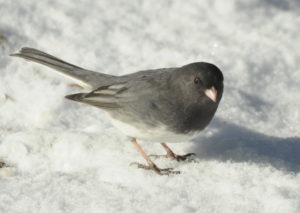 Dark-eyed Junco -By Caroline Gilmore
Dark-eyed Junco -By Caroline GilmoreI have been putting millet out for the ground feeders such as Song, White-throated, and Chipping Sparrows and Eastern Towhees; unfortunately, when I spread food on the ground I am feeding squirrels as well. Another technique to consider for ground feeding birds is to rake your leaves so that these birds can forage beneath them. The ground feeding birds find grubs, larva, and other insects.
 Ruby-crowned Kinglet -By Caroline Gilmore
Ruby-crowned Kinglet -By Caroline GilmoreThe birds, especially the American Goldfinches and the House Finches, are finally eating my nyjer seed. They weren’t eating this seed for months. Are your birds eating nyjer?
Suet has been going fast as well. This provides quick energy for birds so they eat it up fast. I am putting several cakes a day out as they eat it fast. All birds seem to like the suet. I put one cake on the tree for those birds such as woodpeckers and Brown Creepers, who can’t eat suspended suet, and another suspended from a suet feeder. I use the pepper-laced suet sold at local bird seed stores, so that the squirrels won’t eat it.
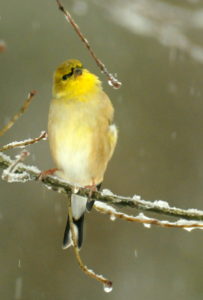 American Goldfinch -By Caroline Gilmore
American Goldfinch -By Caroline GilmoreSome residents, such as American Robins and Eastern Bluebirds, eat berries from the native hollies, the Flowering Dogwoods, and the Eastern Red Cedar trees in your yard. Consider planting these trees if you don’t have any yet. We have seen Cedar Waxwings in our yard eating berries. Have you seen the Cedar Waxwings yet? They are very handsome birds with black masks that visit mostly in the winter.
Despite the snow, it has been very dry. Ensure that your birds have a source of water! Since we are having a very cold spell, please take water out more often or use a heating device to keep your outdoor water unfrozen. I have been taking heated water out to melt the ice in my water feature.
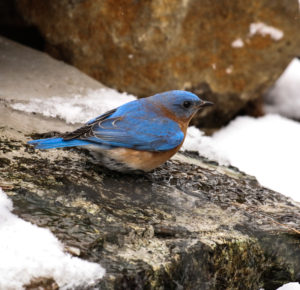 Eastern Bluebird -By Barbara-Driscoll
Eastern Bluebird -By Barbara-DriscollAs I watch the birds checking out and eating from the suet feeders in my yard, I am struck by the notion of “pecking order”. Having heard this term most of my life and having seen how true it is for our feathered friends (and us), I note that the birds appear to be very aware of the pecking order and always yield to the most dominant species! Mostly, the pecking order is based on size of the bird; crows eat first and Ruby-crowned Kinglets eat last. However, in some cases, the aggressiveness of the bird will make up for its size. For example, the Red-bellied Woodpeckers are higher in the pecking order than the Blue Jay, at least at my feeders. In most cases, the birds will eat alone at the suet feeders. In the case of Eastern Bluebirds, they will eat as a gang! Some of the smaller birds will share the suet; the Pine Warblers will share with others of similar size, like the Carolina Wren. Pine Warblers and White-breasted Nuthatches will also sneak onto the suet feeders to get a quick nip before being chased off by the bigger birds! What have you noticed about the pecking order at your feeders?
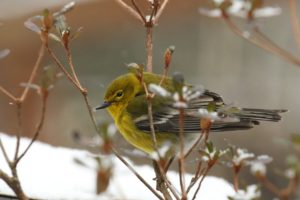 Pine Warbler -By Barbara Driscoll
Pine Warbler -By Barbara DriscollAt this time of year, many of the birds, especially Northern Cardinals, may appear scraggly as they are molting into their new plumage. This is a gradual process that may take several months. During the winter, the juvenile birds will molt into their adult plumage for spring. Have you noticed any shaggy birds coming to your feeders?
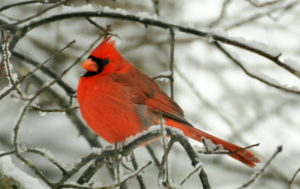 Northern Cardinal -By Caroline Gilmore
Northern Cardinal -By Caroline GilmoreUnfortunately, diseases can be spread at feeders. Some birds, especially House Finches, may appear to have mucus or growths, called conjunctivitis, near their eyes. If this is the case, then please take your feeders down and clean them well.
Although I discuss the birds I am seeing, it will make the articles more interesting if you have ideas about topics to discuss, want to report on the birds you are seeing, or have questions about the birds you are seeing. You can reach me by email at: [email protected]
« Back to All Press